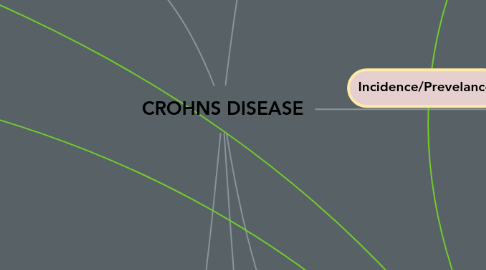
1. References: C. (2017, January 15). What is Crohn's disease? Retrieved September 28, 2017 Ghazi, L. J. (2017, January 6). Crohn Disease. Retrieved September 28, 2017 Krucik, G. T. (Ed.). (2015, March 04). Crohn's Disease by the Numbers: Facts, Statistics, and You. M. (2017, August 07). Crohn's Disease. Retrieved September 28, 2017
2. Diagnostics
2.1. Children & Adults
2.1.1. Blood tests
2.1.1.1. Test for anemia or increase in white blood cells
2.1.2. Stool culture
2.1.2.1. Determines blood loss and infection by a parasite or bacteria
2.1.3. Endoscopy
2.1.3.1. Small camera that examines part of the digestive tract
2.1.4. Biopsy
2.1.4.1. Taking a sample of tissue from colon for laboratory examination
2.1.5. Upper gastrointestinal (GI) series
2.1.5.1. Examination of esophagus, stomach and duodenum
2.1.6. Barium enema
2.1.6.1. Examines large intestine for abnormalities
2.1.7. Colonoscopy
2.1.7.1. Long flexible tube with a light and camera to examine large intestine
3. Treatment
3.1. Surgical
3.1.1. Appropriate when bowel is no longer functional
3.1.1.1. Colostomy
3.1.1.1.1. Opening from colon
3.1.1.2. Ileostomy
3.1.1.2.1. Opening from part of small intestine-ileum
3.2. Non surgical
3.2.1. Anti inflammatory Drugs
3.2.1.1. Corticosteroids
3.2.1.2. Reduce inflammation
3.2.1.3. Oral 5-aminosalicylates
3.2.2. Immune System Suppressors
3.2.2.1. Azathiprine
3.2.2.2. Infliximab
3.2.2.3. Methotrexate
3.2.2.4. Natalizumab
3.2.2.5. Ustekinumab
3.2.3. Antibiotics
3.2.3.1. Help to reduce drainage
3.2.3.2. Heal fistulas
3.2.3.3. Help reduce harmful bacteria
3.2.3.4. Ciproflaxin & metronidazole
3.2.4. Other medications
3.2.4.1. Anti-diarrheals
3.2.4.1.1. Relieve diarrhea
3.2.4.1.2. Psyllium powder and methylcellulose
3.2.4.2. Pain relievers
3.2.4.2.1. Ibuprofen
3.2.4.2.2. Naproxen sodium
3.2.4.2.3. For mild pain
3.2.4.3. Iron supplements
3.2.4.3.1. Help reduce intestinal bleeding
3.2.4.4. Vitamin B-12 shots
3.2.4.4.1. Prevents anemia, promotes natural growth and development-proper nerve function
3.2.4.5. Calcium and vitamin D supplements
3.2.4.5.1. Decrease chances of osteoporosis
4. Pathogenesis
4.1. Autoimmune disorder
4.1.1. Body's immune system attacks healthy cells of the GI tract
4.1.1.1. Leading to inflammation
4.1.2. T regulatory cells are inactive
4.1.2.1. Attacks "self"
4.2. Stages
4.2.1. Mild to moderate
4.2.1.1. Able to eat food normally, without fever, diarrhea and abdominal pain
4.2.2. Moderate to severe
4.2.2.1. Do not respond to mild treatment,high fevers, significant weight loss,stomach pain,anemia, vomiting
4.2.3. Severe
4.2.3.1. High symptoms,fevers, persistent vomiting, blockages in intestines
4.3. Heredity
4.3.1. Genes play a role in the susceptibility of a person
5. Clinical Manifestations (Signs & Symptoms)
5.1. Children
5.1.1. Diarrhea
5.1.2. Abdominal pain
5.1.3. Rectal bleeding
5.1.4. Blood in stool
5.1.5. Fever
5.1.6. Failure to grow
5.2. Adults
5.2.1. Loss of appetite
5.2.2. Diarrhea
5.2.3. Fever
5.2.4. Weight loss
5.2.5. Anemia
5.2.6. Abdominal pain
5.2.7. Anal fissures
6. Risk Factors
6.1. Age
6.1.1. Most people are diagnosed before the age of 30
6.2. Ethnicity
6.2.1. Whites and people of Eastern European (Ashkenazi) Jewish decent have highest risk
6.3. Family History
6.3.1. Higher risk if a parent or sibling has disease
6.3.1.1. 1 in 5 people who have Crohn's disease has a family member with the disease
6.4. Cigarette Smoking
6.4.1. Most important controllable risk factor
6.5. Nonsteriodal Anti-inflammatory Medications
6.5.1. Ibuprofen, and Naproxen
6.5.1.1. Does not cause Crohn's disease, but leads to inflammation of the bowel, worsening the disease
6.6. Where You Live
6.6.1. Urban and industrial areas more likely
6.6.1.1. Suggested environmental factors, including a diet high in fat and refined foods
7. Incidence/Prevelance
7.1. 700,000 Americans have Crohn's disease
7.1.1. Adults: about 241,000
7.1.2. Children and Adolescents: about 57,000
